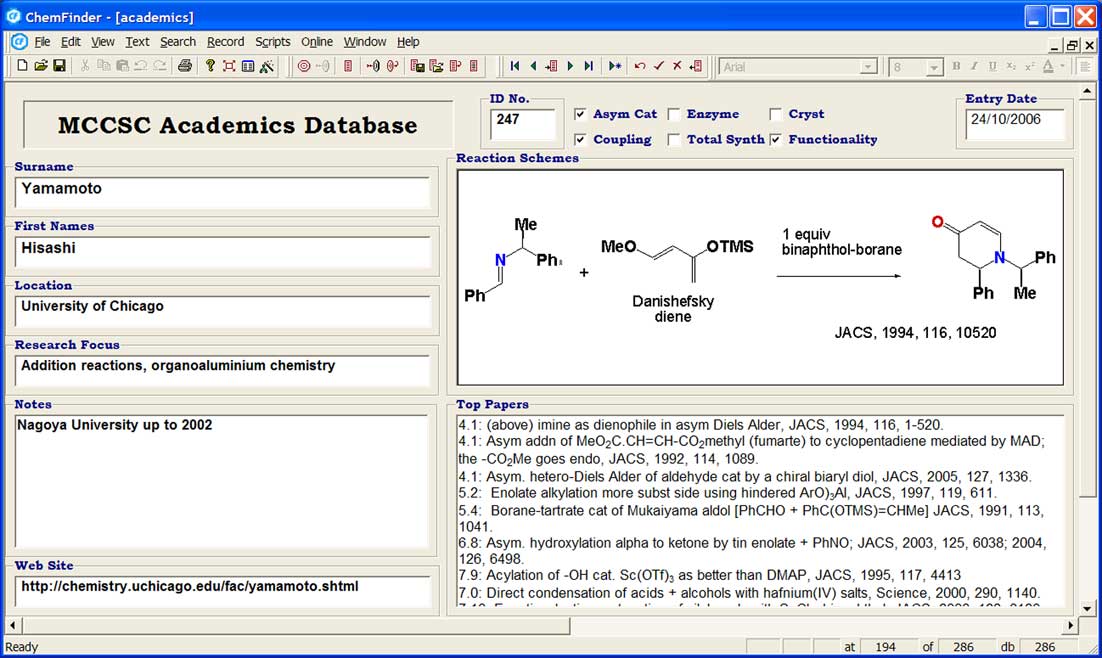Organic Synthesis
In addition to a background of around 25 years experience in organic synthesis, both in medicinal chemistry and
process R&D, the service in organic synthesis benefits from a database of innovative synthetic methods
classified by (a) the lead-researcher, and (b) the type of reaction or technology.
An emphasis is made towards methods that are amenable to scale-up; in particular to catalytic methods of bond
construction, and those based on simple-to-operate condensation chemistries. These are nonetheless suited to
construction of complex molecules such as natural product mimics, and for reactions that control aspects of
stereochemistry. That is particularly so when coupled with Chiral
Technology expertise.
The database, used for this service (a screen shot of one record is shown below) presently covers the work of over
400 researchers and 1000 reactions from the past 20 years carefully selected for their versatility and amenability
to scale-up.

In the past year, some general observations of developments in the organic synthesis methodology field are:
- the rise in methods of organocatalysis (i.e using a catalyst that contains no metal atoms) and within that, the development of catalysts based on thiourea (-NH.C=S.NH-) functionality, such as for asymmetric Mannich reactions (see e.g. Deng et al, J. Am. Chem. Soc., 2006, 128, 6048-9).
- examples of the use of chemocatalysts for resolutions and desymmetrisations, usually the province of biocatalysts. Organocatalysts containing peptide components (see Miller et al, J. Am. Chem. Soc., 2006, 128, 16454-5) form a middle ground between chemocatalysts and biocatalysts.
- the direct C-H activation of alkanes and arenes by dipinacol-diborane with a suitable organometallic catalyst; a spectacular example is the conversion of octane to a 1-boryl derivative with a ruthenium catalyst (Hartwig et al, J. Am. Chem. Soc., 2006, 128, 13684-5).
- the emergence of catalysts based on gold for the activation of unsaturated substrates (especially alkynes and allenes) to addition and cyclisation reactions.
The researchers who feature most prominently due to the relevance of their methodologies are:
R. Noyori, S.L. Buchwald, B.M. Trost, E.J. Corey, P. Knochel, D.A. Evans, A.I. Meyers, J. Hartwig, B. Feringa,
K.B. Sharpless, A.J. Pearson, K. Maruoka, M. Reetz, E.N. Jacobsen, W. Oppolzer, S.G. Davies, H. Yamamoto, M. Beller,
T. Ikariya, B.H. Lipsutz, M.J. Burk, T. Hayashi, X. Zhang and S. Kobayashi.
Examples of areas where advice can be particularly focussed are listed as follows:
- Catalytic Hydrogenation
- Conjugate (Michael) Additions
- Addition to Imines (Mannich, Strecker, Pictet Spengler, Ugi)
- Coupling to Carbonyl Functionality (Aldol, Claisen Condensation, Dieckmann, Baylis-Hillman)
- Rearrangements/Allylic Transfer(Claisen, Cope rearrangement; Ene Reaction, Trost chemistry)
- Alkene and Arene couplings (Suzuki, Heck, Sonogashira, Organozinc-mediated)
- Addition to Alkynes (Negichi, Dixneuf)
- Annulations (Diels Alder, Robinson Annulation)
- Oxidative Rearrangements (Baeyer-Villiger, Beckmann Rearrangement)
- Olefin Heteroadditions (Halolactonization, Ritter, Wacker oxidation)
- Carboxylate Modification (Curtius)
- Quaternary-Carbon Construction
- Arene Modification (Birch Reduction, Lithiation, Aromatic Substitution)
- Biocatalysis (with Hydrolases, Oxidoreductases)